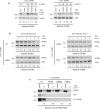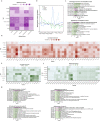Mutation of key signaling regulators of cerebrovascular development in vein of Galen malformations
- PMID: 37978175
- PMCID: PMC10656524
- DOI: 10.1038/s41467-023-43062-z
Mutation of key signaling regulators of cerebrovascular development in vein of Galen malformations
Abstract
To elucidate the pathogenesis of vein of Galen malformations (VOGMs), the most common and most severe of congenital brain arteriovenous malformations, we performed an integrated analysis of 310 VOGM proband-family exomes and 336,326 human cerebrovasculature single-cell transcriptomes. We found the Ras suppressor p120 RasGAP (RASA1) harbored a genome-wide significant burden of loss-of-function de novo variants (2042.5-fold, p = 4.79 x 10-7). Rare, damaging transmitted variants were enriched in Ephrin receptor-B4 (EPHB4) (17.5-fold, p = 1.22 x 10-5), which cooperates with p120 RasGAP to regulate vascular development. Additional probands had damaging variants in ACVRL1, NOTCH1, ITGB1, and PTPN11. ACVRL1 variants were also identified in a multi-generational VOGM pedigree. Integrative genomic analysis defined developing endothelial cells as a likely spatio-temporal locus of VOGM pathophysiology. Mice expressing a VOGM-specific EPHB4 kinase-domain missense variant (Phe867Leu) exhibited disrupted developmental angiogenesis and impaired hierarchical development of arterial-capillary-venous networks, but only in the presence of a "second-hit" allele. These results illuminate human arterio-venous development and VOGM pathobiology and have implications for patients and their families.
© 2023. The Author(s).
Conflict of interest statement
The authors declare no competing interests.
Figures








References
Publication types
MeSH terms
Substances
Grants and funding
- R01 NS109358/NS/NINDS NIH HHS/United States
- R01 HL146352/HL/NHLBI NIH HHS/United States
- R01 NS111029/NS/NINDS NIH HHS/United States
- R01 NS131610/NS/NINDS NIH HHS/United States
- R00 HL143036/HL/NHLBI NIH HHS/United States
- K99 HL143036/HL/NHLBI NIH HHS/United States
- UL1 TR001863/TR/NCATS NIH HHS/United States
- R01 HL120888/HL/NHLBI NIH HHS/United States
- U54 HG006504/HG/NHGRI NIH HHS/United States
- R01 NS117609/NS/NINDS NIH HHS/United States
- T32 GM007205/GM/NIGMS NIH HHS/United States
- TL1 TR001864/TR/NCATS NIH HHS/United States
LinkOut - more resources
Full Text Sources
Medical
Molecular Biology Databases
Research Materials
Miscellaneous

